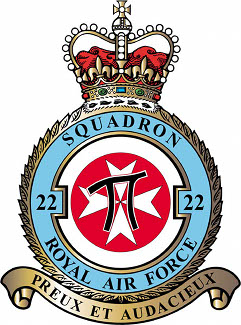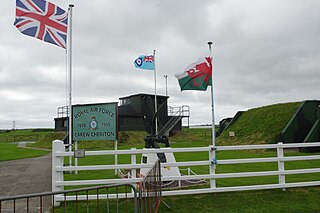
Number 22 Squadron of the Royal Air Force is an operational testing and evaluation squadron for all the Joint Helicopter Command helicopter types including Chinook, Puma HC2, Merlin HC4, Apache and Wildcat AH1. Formerly the Rotary Wing Operational Evaluation and Training Unit, the highly experienced helicopter aircrew will also ensure frontline crews have Qualified Warfare Instructors to support them on operations worldwide. The squadron was reformed in May 2020 to serve as the Joint Helicopter Command Operational Evaluation Unit.

Tain Air Weapons Range is a Ministry of Defence air weapons range on the Dornoch Firth near Tain in Scotland. Royal Air Force aircrews from RAF Lossiemouth are trained in air weaponry on the range, along with NATO aircrew.

Royal Air Force Haverfordwest or more commonly RAF Haverfordwest, is a former Royal Air Force station located 2.1 miles (3.4 km) north of Haverfordwest, Pembrokeshire and 11 miles (18 km) south of Fishguard, Pembrokeshire, Wales.

Royal Air Force Carew Cheriton, or more simply RAF Carew Cheriton, is a former Royal Air Force station located near Carew, Pembrokeshire. It was situated 4.7 miles (7.6 km) north west of Tenby.

Royal Air Force Thorney Island, or more simply RAF Thorney Island, is a former Royal Air Force station located on Thorney Island, West Sussex, England, 6.6 miles (10.6 km) west of Chichester and 7.1 miles (11.4 km) east of Portsmouth, Hampshire.

No. 217 Squadron RAF was a squadron of the RAF. It was formed and disbanded four times between 1 April 1918 and 13 November 1959. In World War I it served in a strike role against enemy bases and airfields in Belgium. In World War II as part of RAF Coastal Command it served first in a maritime patrol role along the Western Approaches and later in an anti-shipping role in the English Channel. Ordered to the Far East in 1942, the squadron was retained for two months in Malta in an anti-shipping role, protecting Allied convoys, before moving to Ceylon to defend the approaches to India, serving in an anti-submarine and anti-shipping role. It was equipped and training for a strike role, when the war ended. In the postwar period, it served for five years in a maritime reconnaissance role, and then briefly in a support role for Operation Grapple, the British hydrogen bomb tests on Christmas Island.
RAF Turnberry was an airfield in Scotland used by the Royal Flying Corps (RFC) and the Royal Air Force (RAF) during the First World War, and again by the RAF in the Second World War. Between the two wars, the site reverted to its pre-1914 use as the Turnberry Golf Course and hotel. It reverted to this use again after the Second World War. Although there is still a disused landing strip, the site is now the Trump Turnberry.

No. 1 (Coastal) Operational Training Unit RAF, was a training unit of the Royal Air Force, within No. 17 Group RAF, which was part of RAF Coastal Command. The unit was established during April 1940 by the redesignating of an existing RAF Coastal Command unit, and disbanded during October 1943.

No. 2 (Coastal) Operational Training Unit RAF, was a training unit of the Royal Air Force, within No. 17 Group RAF, which was part of RAF Coastal Command. The unit started operating from late 1940 and disbanded during early 1944.

No. 3 (Coastal) Operational Training Unit RAF, was a training unit of the Royal Air Force, within No. 17 Group RAF, which was part of RAF Coastal Command. The unit started operating from late 1940 and disbanded at the start of 1944, being absorbed into No. 6 OTU.

No. 16 Group RAF was a group of the Royal Air Force. It existed over two periods in two different roles. No. 16 Group was initially a training group, from 1918 to 1920, that had been transferred from the Royal Flying Corps. It reformed as a reconnaissance group under RAF Coastal Command, in 1936.

No. 17 Group RAF was a group of the Royal Air Force which was operational in the last year of the First World War, and throughout the Second World War.

Flying Boat Training Squadron RAF is a former Squadron of the Royal Air Force which was operational between 1931 and 1956 through various names.

Coastal Command Anti U-Boat Devices School RAF was a training unit of the Royal Air Force and part of RAF Coastal Command. The unit was established during April 1945 by the redesignating of an existing RAF Coastal Command unit. The unit had several different identities beforehand. It began as the short lived No. 7 Operational Training Unit which only existed during 1940, before reforming in 1942 as No. 7 (Coastal) Operational Training Unit. It disbanded and was redesignated a few more times before becoming the Coastal Command Anti U-Boat Devices School.

No. 9 (Coastal) Operational Training Unit RAF, was a training unit of the Royal Air Force, within No. 17 Group RAF, which was part of RAF Coastal Command. The unit was established during June 1942 and disbanded during August 1944.

No. 132 (Coastal) Operational Training Unit RAF, was a training unit of the Royal Air Force, within No. 17 Group RAF, part of RAF Coastal Command. The unit was established during November 1942 and disbanded during May 1946.

Air-Sea Warfare Development Unit RAF (ASWDU) was a research and development unit of the Royal Air Force, within RAF Coastal Command, it was operational from December 1940 and disbanded in April 1970.

No. 5 (Coastal) Operational Training Unit RAF, was a training unit of the Royal Air Force, within No. 17 Group RAF, which was part of RAF Coastal Command. The unit was established during August 1941 and disbanded during August 1945.








